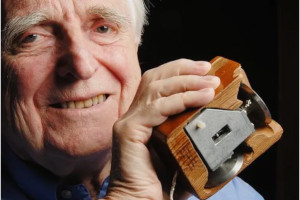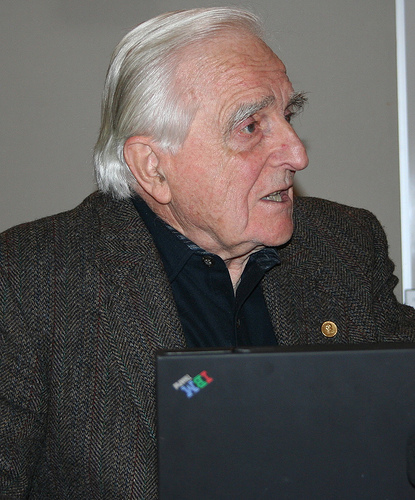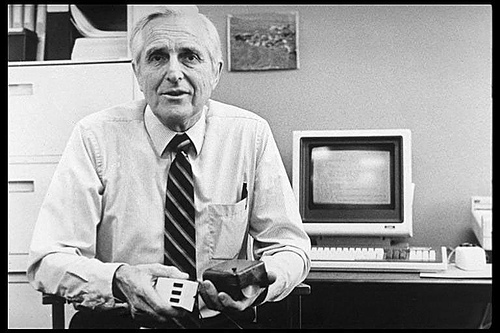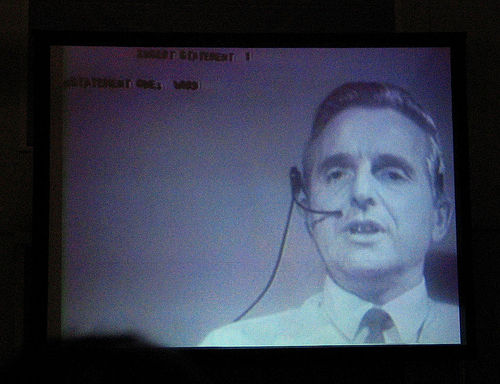 DOUGLAS CARL ENGELBART
DOUGLAS CARL ENGELBART
The inventor of the mouse####, of teleconferencing, creator of the GUI window interface####, precursor of hypertext#### and one of the fathers of the internet.
|--> 01-30-1925
-->| 02-07-2013
History:
Douglas Engelbart was born in 1925, in Oregon, where he grew up on a small farm. In 1942, he graduated from high school and enrolled at Oregon State University to study electrical engineering. His studies are interrupted by the Second World War. He enlisted in the Navy and spent two years in the Philippines as a radar technician. Here he reads an article that impresses and influences him throughout his life: Vannevar Bush's "As We may Think." on the meaning of science and its uses in peace and war.
Engelbart returned to school after the war and graduated in 1948. He began working at the NACA Ames Laboratory which is a forerunner of NASA. He was thinking about the world and how it was developing more and more complexly, and he recalled his experience from reading Bush's article. He began to imagine people in front of screens, "flying" into an information space where they could formulate and organize their ideas with incredible speed and flexibility. All of this of course long before the internet and the web existed.
With this new target in mind, Engelbart enrolled in UC Berkeley's electrical engineering graduate program and earned his Ph.D. in 1955. He was an Assistant Professor at Berkeley, but soon realized that his dreams of using computers to boost human intelligence were very far from being realized in this way. Engelbart left Berkeley and obtained a research position at the Stanford Research Institute (SRI).
At SRI, Engelbart formulated a new discipline in order to help organizations survive the increasing complexity and rapidity of change they were forced to face with the exponential growth of technology, or, as he always said, with the increase of intellect human. In 1962, he wrote "On the Increase of Human Intellect," a conceptual work on the fact that as human intellect increases, one acquires the ability to tackle and solve ever more complex problems, in ever shorter time frames.
In 1963, Engelbart set up his own research laboratory. He called it the Augmentation Research Center. From the 1960s to the 1970s his laboratory developed an elaborate hypermedia - group system called the NLS (oNLine System). The NLS facilitates the creation of digital libraries and document collections using hypertext. This was the first successful implementation of #### hypertext. NLS used a new tool to facilitate interaction with the computer: the mouse####. The mouse was not adopted for general use until 1980 when Apple#### computers began using it. NLS also created new #### graphical user interfaces by developing a windowing environment that allowed the user to manage mail as well as offering a large variety of text handling options. Perhaps more importantly, NLS also builds an on-screen #### video teleconferencing system. All of these technologies, which are ubiquitous today, were mind-blowing in the 1960s.
In 1968, at the Fall Joint Computer Conference in San Francisco, Engelbart demonstrated NLS in a 90-minute multimedia presentation, which included a real-time video conference with staff in the lab 30 miles away. The uproar was enormous, and that demo was called "the mother of all demos", there was someone who didn't want to believe it possible and thought it was all a fiction. It was in that demo that all the main concepts currently used and applied in modern PCs were proposed and conceived.
Engelbart developed NLS with funds from ARPA. He was excited by what the new ARPA network was building. He saw it as a vehicle to extend NLS and enhance and distribute collaboration. "I realized there was a ready-made community of computers," Engelbart said. "It was just what I was looking for." Engelbart's lab had become the second node in the ARPANET network.
Engelbart was very involved in the whole project and to merge the Network Information Center (NIC) which used NLS as a sort of online clearinghouse for ARPANET resources.
Engelbart continued to work on research to augment human intellect, rarely receiving the acclaim he might have deserved. In 1989, he founded the Bootstrap Institute to encourage high performance organizations by developing technologies and promoting collaboration.
He has long had an office at Logitech, but prefers to focus on the Bootstrap project.
He died peacefully in his sleep at the age of 88.
Fonti:
http://www.ibiblio.org/pioneers/englebart.html
https://it.wikipedia.org/wiki/Douglas_Engelbart
|
Engelbart and his mouse |
During a convenction - (CC) |
In the laboratory - (CC) |
|
During the famous demo - (CC) |






